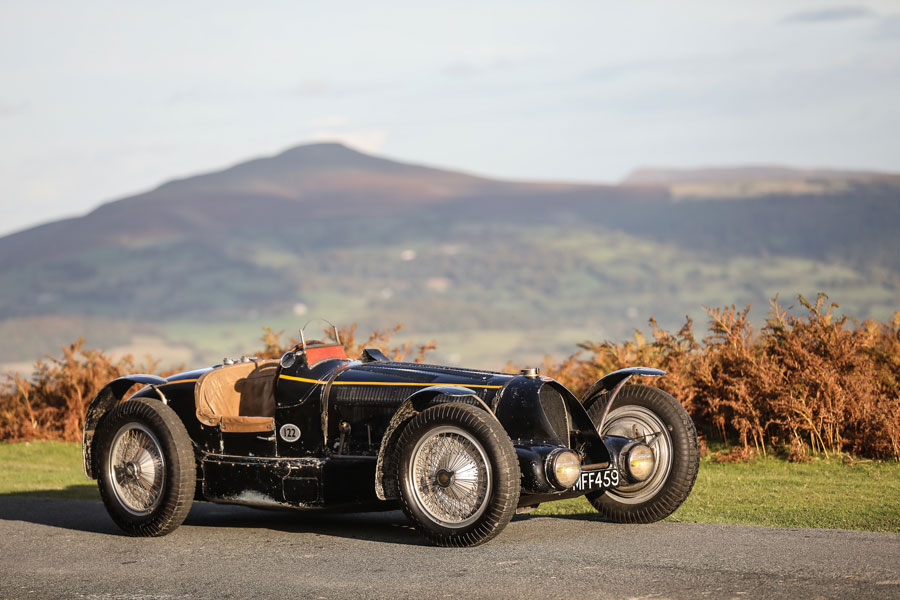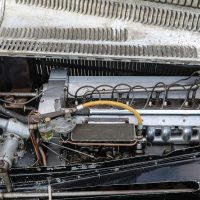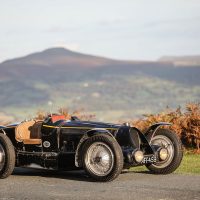SCM Analysis
Detailing
| Vehicle: | 1934 Bugatti Type 59 Sports |
| Years Produced: | 1933–37 |
| Number Produced: | Six |
| Tune Up Cost: | $2,000 |
| Chassis Number Location: | Chassis plate on firewall engine side |
| Engine Number Location: | Rear left engine mount |
| Club Info: | American Bugatti Club |
| Website: | http://www.americanbugatticlub.org |
| Alternatives: | 1939 Alfa Romeo 8C 2900 Spider, 1936–38 Bugatti Type 57SC Atalante, 1937 Delahaye 145 Grand Prix |
This car, Lot 4, sold for $12,640,750 (£9,535,000) at Gooding & Company’s “Passion of a Lifetime” sale at the Concours of Elegance at Hampton Court Palace near London on September 5, 2020.
David Gooding had been quietly looking for the right opportunity to enter the overcrowded European auction scene for a long time. Quite rightly, he had no wish to join the plethora of auction houses fighting for euros during a few days around Rétromobile in Paris. The opportunity came with Hubert Fabri’s “Passion of a Lifetime” collection. By American standards, it was fairly small. But many of the cars would be the star attraction at other auctions. Gooding’s patience paid off. He didn’t tentatively dip his toes into the European scene — he hit a home run.
The star of the show was the Type 59 Bugatti. Its catalog description was brief. Gooding assumed that anyone planning on spending somewhere near the estimate of over £10m would do due diligence. On that note, it is almost impossible to trace the individual racing history of a Type 59. The cars were entered with their engine numbers, with engines swapped between chassis as needed. So 57248 would have originally had a chassis number starting with 59, which was then changed to a 57 number for its sports-car career.
Bugatti builds its legend
To understand this car’s origins, we need to go back to 1924. This was the year that Bugatti first made and raced the legendary Type 35 that quickly became almost unbeatable. The T35 echoed the principle of all Bugattis. They should not simply be fast and efficient — every single piece of the car needed to look great. The curved chassis didn’t perform any better than a straight one, but it followed the sensual shape of the body. The revolutionary cast-alloy wheels incorporated the brake drums. And the straight-8, all-aluminum engine simply invited the owner to open the hood to show off its beauty.
Technology was rapidly evolving, and over the next few years, the engine grew from 2 liters to 2.3, and a supercharger was added. The last evolution was the Type 51, which received a twin-cam head. Inevitably, the competition (especially Alfa Romeo) caught up with and then bettered its performance. In 1931, Bugatti’s reply was the Type 54. Although resembling the T35, it was bigger, far heavier, and had the 4.9-liter engine from the Type 50 road car shoehorned in. It was fast in a straight line but didn’t stop and didn’t go around corners. It was a widowmaker, and thankfully only six were made.
By 1933, like most luxury car makers, Bugatti was in a bad financial state. Ettore’s dream project, the Type 41 Royale, could not find any takers. To save the company, Bugatti started making high-speed luxury railcars, powered by multiple units of the 12-liter engine designed for the Royale. Despite the lack of money to come up with something truly new, he also produced his last Grand Prix car, the Type 59.
Beautiful loser
You won’t find many enthusiasts who don’t agree that the T59 was the most beautiful pre-war Grand Prix car. The chassis was slightly longer and wider than the 35/51, and the unique “piano wire” wheels are gorgeous. The twin-cam, straight-8 engine was based on the T57 touring car, with dry-sump lubrification, initially with a displacement of 2,800 cc, then enlarged to 3,300, producing 250 horsepower. It was a great car, and had Bugatti built it a couple of years earlier instead of the T54, it would have been a winner. But it was too little, too late. Alfa Romeo had some financial help from the Italian government, and state-backed Mercedes and Auto Union were about to burst onto the scene.
Bugatti laid down six T59 chassis, and teams of four cars were dispatched to the European race circuits in the latter part of 1933, alas, with little success. For 1934, the engines were upgraded to 3.3 liters, along with a new dry-sump gearbox, separated from the engine. But wins were hard to come by. By the end of the 1934 season, Bugatti realized that his beautiful car simply wasn’t fast enough, and he sold four of the cars to privateers, all in England.
In 1936, Bugatti audaciously took two cars to the Grand Prix du Comminges, a race for sports cars. Cycle wings were hastily bolted on to conform with regulations. The T59 was a nominal two-seater and was allowed to race despite vociferous objections from other competitors. The Bugatti won by a country mile, and thus entered its second career. For the 1937 season, the two remaining factory cars had their bodies transformed from the firewall backwards, with a cowled radiator and a rounded rear end that housed the spare wheel. This effectively put a stop to the complaints. The cars were entered almost exclusively in French events, and comprehensively trounced the field.
Time-capsule condition
Towards the end of the season, 57248 was sold (or perhaps given) to King Leopold of Belgium, a serial Bugatti buyer and enthusiast. He used it sparingly, then salted it away. Stephane Falise, who had a close relationship with the royal family, acquired the car sometime in the mid-1960s. Falise lived in a tree-lined, affluent Brussels suburb, surrounded by mock Tudor houses. His abode stood out from all the rest. It was built in the minimalist style of the late 1930s by Corbusier and was untouched both outside and inside.
When I visited him about 15 years ago, it was a time capsule, even the kitchen. He was a conservationist. In another part of town, he had an old factory building stuffed with French cars, all of them in original condition, and none of them having turned a wheel for a long time. He could have thrown a new coat of paint onto the scruffy Bugatti, but he didn’t. He was happy to sit and look at it. I doubt he ever drove it. He loved cars in their original state at a time when anyone else would have restored them. Falise’s time as custodian was, critically, what saved this icon.
In 1989, Falise sold the car to American collector Bob Rubin, presumably on the premise that the car remain original. Rubin had the car’s mechanicals gone over, then sold it about a decade later to another American collector, Anthony Wang, who hardly ever used the car. It was sold to Hubert Fabri around 2008.
A new home
A historic work of art from what many people believe to be the world’s most iconic manufacturer, this T59 will now head to the Swiss “Pearl Collection.” Astoundingly, it is wearing the same coat of paint and leather that it got 83 years ago. So did the buyer get himself a good, bad or indifferent deal?
The only logical comparison on value would be the Alfa Romeo 8C 2900 Spider. They are rare but not unique. If a 2900 came to auction today in similar condition and with similar history, we would expect it to make well over $25m. So this acquisition was a no-brainer for the buyer, who, incidentally, also purchased the Bugatti Type 57S Atalante in the same sale, even though he already has one. He would have paid significantly more if necessary. (And with the pound sterling in freefall in September, assuming he was patient enough to wait before paying, he could have saved himself nearly half a million dollars.)
Why was the T59 inexpensive? Simply a reflection of today’s marketplace. Successful young businessmen have little interest in cars that are older than their grandfathers. Prices have dropped across the board in the past couple of years for high-end classic cars. And certainly not least, we are missing the excitement of a crowded auction room, filled with real humans, vying with each other to purchase a sexy motorcar. ♦
(Introductory description courtesy of Gooding & Company.)




